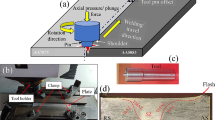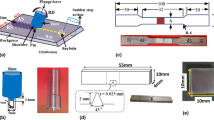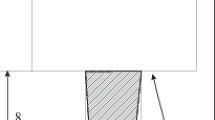Abstract
Metallurgical structure, mechanical properties and electrochemical behavior of dissimilar friction stir welding (FSW) between structural AA5083 and AA1050 alloys were investigated in this study. Optical microscopy and field emission scanning electron microscopy observations showed that the nugget zone (NZ) possesses equiaxed recrystallized grains of the two alloys with a flowing shape. Energy-dispersive spectroscopy analysis revealed that NZ is mainly composed of the advancing side alloy. The ultimate tensile and yield strengths of the dissimilar FSW joint were higher than those of AA1050 and lower than those of AA5083. Consequently, fracture occurred on AA1050 side during the tensile tests. The potentiodynamic polarization (PDP) results revealed that the passive current density of the FSW joint was in between that of AA1050 and AA5083. A modified Randles equivalent circuit was used to simulate the obtained experimental data of electrochemical impedance spectroscopy measurements. The acquired impedance parameters were in good agreement with the PDP measurements.












Similar content being viewed by others
References
Pérez-Bergquist SJ, Gray GT, Cerreta EK, Trujillo CP, Pérez-Bergquist A (2011) The dynamic and quasi-static mechanical response of three aluminum armor alloys: 5059, 5083 and 7039. Mater Sci Eng, A 528:8733–8741
Katsas S, Nikolaou J, Papadimitriou G (2006) Microstructural changes accompanying repair welding in 5xxx aluminium alloys and their effect on the mechanical properties. Mater Des 27:968–975
Fattah-alhosseini A, Naseri M, Alemi MH (2017) Effect of particles content on microstructure, mechanical properties, and electrochemical behavior of aluminum-based hybrid composite processed by accumulative roll bonding process. Metall Mater Trans A 48(3):1343–1354
Thomas WM, Nicholas ED, Needham JC, Murch MG, Temple-Smith P, Dawes CJ (1991) International patent application PCT/GB92/02203 and GB Patent Application 9125978.8, UK Patent Office, London, December 6, 1991
Dawes CJ, Thomas WM (1995) TWI Bulletin 6, November/December, 1995, 124
Lee WB, Yeon YM, Jung SB (2003) The improvement of mechanical properties of friction-stir-welded A356 Al alloy. Mater Sci Eng, A 355:154–159
Nandan R, Roy GG, Lienert TJ, Debroy T (2007) Three-dimensional heat and material flow during friction stir welding of mild steel. Acta Mater 55:883–895
Fattah-alhosseini A, Taheri AH (2015) Effect of friction stir welding on corrosion behavior of pure copper in 3.5 wt% NaCl solution. J Manuf Process 20:98–103
Sato YS, Kokava H (2001) Distribution of tensile property and microstructure in friction stir weld of 6063 aluminum. Metall Mater Trans A 32:3023–3031
Elangovan K, Balasubramanian V (2008) Influences of tool pin profile and tool shoulder diameter on the formation of friction stir processing zone in AA6061 aluminum alloy. Mater Des 29:362–373
Babu S, Elangovan K, Balasubramanian V, Balasubramanian M (2009) Optimizing friction stir welding parameters to maximize tensile strength of AA2219 aluminum alloy joints. Met Mater Int 15:321–330
Zhang Z, Xiao BL, Ma ZY (2012) Effect of welding parameters on microstructure and mechanical properties of friction stir welded 2219Al-T6 joints. J Mater Sci 47:4075–4086. https://doi.org/10.1007/s10853-012-6261-1
Liu HJ, Zhou L, Liu QW (2010) Microstructural characteristics and mechanical properties of friction stir welded joints of Ti–6Al–4V titanium alloy. Mater Des 31:1650–1655
Zhou L, Liu HJ, Liu QW (2010) Effect of rotation speed on microstructure and mechanical properties of Ti–6Al–4V friction stir welded joints. Mater Des 31:2631–2636
Zhou L, Liu HJ, Liu P, Liu QW (2009) The stir zone microstructure and its formation mechanism in Ti–6Al–4V friction stir welds. Scr Mater 61:596–599
Shen C, Zhang J, Ge J (2011) Microstructures and electrochemical behaviors of the friction stir welding dissimilar weld. J Environ Sci 23:S32–S35
Park SK, Hong ST, Park JH, Park KY, Kwon YJ, Son HJ (2010) Effect of material locations on properties of friction stir welding joints of dissimilar aluminium alloys. Sci Technol Weld Join 15:331–336
Liu XC, Sun YF, Fujii H (2017) Clarification of microstructure evolution of aluminum during friction stir welding using liquid CO2 rapid cooling. Mater Des 129:151–163
Cabibbo M, Forcellese A, Simoncini M, Pieralisi M, Ciccarelli D (2016) Effect of welding motion and pre-/post-annealing of friction stir welded AA5754 joints. Mater Des 93:146–159
Aval HJ (2015) Microstructure and residual stress distributions in friction stir welding of dissimilar aluminium alloys. Mater Des 87:405–413
Carter H, Stanisaw D, Marek B (2008) A model of material flow during friction stir welding. Mater Charact 59:1206–1214
Hu ZL, Wang XS, Yuan SJ (2012) Quantitative investigation of the tensile plastic deformation characteristic and microstructure for friction stir welded 2024 aluminum alloy. Mater Charact 73:114–123
Amra M, Ranjbar Kh, Dehmolaei R (2015) Mechanical properties and corrosion behavior of CeO2 and SiC incorporated Al5083 alloy surface composites. J Mater Eng Perform 24(8):3169–3179
Alvand M, Naseri M, Borhani E, Abdollah-Pour H (2017) Nano/ultrafine grained AA2024 alloy processed by accumulative roll bonding: a study of microstructure, deformation texture and mechanical properties. J Alloy Compd 712:517–525
Amra M, Ranjbar Kh, Hosseini SA (2018) Microstructure and wear performance of Al5083/CeO2/SiC mono and hybrid surface composites fabricated by friction stir processing. Trans Nonferrous Metals Soc China 28(5):866–878
Chowdhury SM, Chen DL, Bhole SD, Cao X (2010) Tensile properties of a friction stir welded magnesium alloy: effect of pin tool thread orientation and weld pitch. Mater Sci Eng A 527:6064–6075
Ueji R, Fujii H, Cui L, Nishioka A, Kunishige K, Nogi K (2006) Friction stir welding of ultrafine grained plain low-carbon steel formed by the martensite process. Mater Sci Eng A 423:324–330
Gashti SO, Fattah-alhosseini A, Mazaheri Y, Keshavarz MK (2016) Microstructure, mechanical properties and electrochemical behavior of AA1050 processed by accumulative roll bonding (ARB). J Alloys Compd 688:44–55
Naseri M, Hassani A, Tajally M (2015) An alternative method for manufacturing Al/B4C/SiC hybrid composite strips by cross accumulative roll bonding (CARB) process. Ceram Int 41(10, Part A):13461–13469
Fattah-alhosseini A, Naseri M, Alemi MH (2016) Corrosion behavior assessment of finely dispersed and highly uniform Al/B4C/SiC hybrid composite fabricated via accumulative roll bonding process. J Manuf Process 22:120–126
Abdulstaar M, Mhaede M, Wagner L, Wollmann M (2014) Corrosion behaviour of Al 1050 severely deformed by rotary swaging. Mater Des 57(2014):325–329
Davoodi A, Esfahani Z, Sarvghad M (2016) Microstructure and corrosion characterisation of the interfacial region in dissimilar friction stir welded AA5083 to AA7023. Corros Sci 107:133–144
Hariri MB, Shiri SG, Yaghoubinezhad Y, Rahvard MM (2013) The optimum combination of tool rotation rate and traveling speed for obtaining the preferable corrosion behavior and mechanical properties of friction stir welded AA5052 aluminum alloy. Mater Des 50:620–634
Macdonald JR, Barsoukov E (2005) Impedance spectroscopy: theory, experimentand applications. Wiley, Hoboken
Escrivà-Cerdán C, Blasco-Tamarit E, García-García D, García-Antón J, Akid R, Walton J (2013) Effect of temperature on passive film formation of UNS N08031 Cr–Ni alloy in phosphoric acid contaminated with different aggressive anions. Electrochim Acta 111:552–561
Vafaeian S, Fattah-alhosseini A, Keshavarz MK, Mazaheri Y (2016) The influence of cyclic voltammetry passivation on the electrochemical behavior of fine and coarse-grained AISI, 430 ferritic stainless steel in an alkaline solution. J Alloys Compd 677:42–51
Fattah-alhosseini A, Gashti SO (2015) Corrosion behavior of ultra-fine grained 1050 aluminum alloy fabricated by ARB process in a buffer borate solution. J Mater Eng Perform 24(2015):3386–3393
Acknowledgements
This study is financially supported by the Dr. A. Fattah-alhosseini’s Research Lab at Department of Materials Engineering, Bu-Ali Sina University, Hamedan, Iran. The authors are grateful for these supports. Also, M. Naseri and D. Gholami acknowledge support for the FSW facilities and simulation provided in part by the Materials Processing Simulation Lab (MPSLab), School of Metallurgy and Materials Engineering, Iran University of Science and Technology, Tehran, Iran.
Author information
Authors and Affiliations
Corresponding author
Rights and permissions
About this article
Cite this article
Fattah-alhosseini, A., Naseri, M., Gholami, D. et al. Microstructure and corrosion characterization of the nugget region in dissimilar friction-stir-welded AA5083 and AA1050. J Mater Sci 54, 777–790 (2019). https://doi.org/10.1007/s10853-018-2820-4
Received:
Accepted:
Published:
Issue Date:
DOI: https://doi.org/10.1007/s10853-018-2820-4




